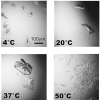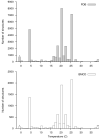'Hot' macromolecular crystals
- PMID: 20161694
- PMCID: PMC2809425
- DOI: 10.1021/cg900971h
'Hot' macromolecular crystals
Abstract
Transcriptional regulator protein TM1030 from the hyperthermophile Thermotoga maritima, as well as its complex with DNA, was crystallized at a wide range of temperatures. Crystallization plates were incubated at 4, 20, 37 and 50° C over 3 weeks. The best crystals of TM1030 in complex with DNA were obtained at 4, 20 and 37° C, while TM1030 alone crystallized almost equally well in all temperatures. The crystals grown at different temperatures were used for X-ray diffraction experiments and their structures were compared. Surprisingly, the models of TM1030 obtained from crystals grown at different temperatures are similar in quality. While there are some examples of structures of proteins grown at elevated temperatures in the PDB, these temperatures appear to be underrepresented. Our studies show that crystals of some proteins may be grown and are stable at broad range of temperatures. We suggest that crystallization experiments at elevated temperatures could be used as a standard part of the crystallization protocol.
Figures




Similar articles
-
Crystal structure of a transcriptional regulator TM1030 from Thermotoga maritima solved by an unusual MAD experiment.J Struct Biol. 2007 Sep;159(3):424-32. doi: 10.1016/j.jsb.2007.04.012. Epub 2007 May 16. J Struct Biol. 2007. PMID: 17588774 Free PMC article.
-
Macromolecular crystal growth experiments on International Microgravity Laboratory--1.Protein Sci. 1992 Oct;1(10):1254-68. doi: 10.1002/pro.5560011004. Protein Sci. 1992. PMID: 1303744 Free PMC article.
-
Crystallization and preliminary X-ray analysis of RecG, a replication-fork reversal helicase from Thermotoga maritima complexed with a three-way DNA junction.Acta Crystallogr D Biol Crystallogr. 2001 Nov;57(Pt 11):1695-6. doi: 10.1107/s0907444901013105. Epub 2001 Oct 25. Acta Crystallogr D Biol Crystallogr. 2001. PMID: 11679748
-
Locating and Visualizing Crystals for X-Ray Diffraction Experiments.Methods Mol Biol. 2017;1607:143-164. doi: 10.1007/978-1-4939-7000-1_6. Methods Mol Biol. 2017. PMID: 28573572 Review.
-
Macromolecular cryocrystallography--methods for cooling and mounting protein crystals at cryogenic temperatures.Methods. 2004 Nov;34(3):415-23. doi: 10.1016/j.ymeth.2004.03.032. Methods. 2004. PMID: 15325658 Review.
Cited by
-
Unmet challenges of structural genomics.Curr Opin Struct Biol. 2010 Oct;20(5):587-97. doi: 10.1016/j.sbi.2010.08.001. Epub 2010 Aug 31. Curr Opin Struct Biol. 2010. PMID: 20810277 Free PMC article. Review.
-
To automate or not to automate: this is the question.J Struct Funct Genomics. 2010 Sep;11(3):211-21. doi: 10.1007/s10969-010-9092-9. Epub 2010 Jun 6. J Struct Funct Genomics. 2010. PMID: 20526815 Free PMC article.
-
Data management in the modern structural biology and biomedical research environment.Methods Mol Biol. 2014;1140:1-25. doi: 10.1007/978-1-4939-0354-2_1. Methods Mol Biol. 2014. PMID: 24590705 Free PMC article.
References
-
- Lehmann M, Pasamontes L, Lassen SF, Wyss M. The consensus concept for thermostability engineering of proteins. Biochim. Biophys. Acta. 2000;1543:408–415. - PubMed
-
- Basak S, Ghosh TC. On the origin of genomic adaptation at high temperature for prokaryotic organisms. Biochem. Biophys. Res. Commun. 2005;330:629–32. - PubMed
-
- Boistelle R, Astier JP. CRYSTALLIZATION MECHANISMS IN SOLUTION. J. Cryst. Growth. 1988;90:14–30.
-
- Budayova-Spano M, Dauvergne F, Audiffren M, Bactivelane T, Cusack S. A methodology and an instrument for the temperature-controlled optimization of crystal growth. Acta Crystallogr. Sect. D. 2007;63:339–47. - PubMed
Grants and funding
LinkOut - more resources
Full Text Sources
